

●プログラム
8月17日(金)
14:30ーレセプション, ウェルカムミーティング
15:30ー
ワークショップ1 ミヒャエル・フィッシャー 参加型の「自由即興オーケストラ」
ワークショップ2 寺内大輔 「口琴やろうぜ」 口琴をお持ちの方は、持参下さい(お持ちでない方も参加できます)
(裏ワークショップ募集中)
夕食タイム(バーベキュー)
ワークショップ3 トレヴァー・ウィシャート 「声の探求」
セッション1 コーディネーター:未定
8月18日(土)
8:30ー朝食タイム
9:30ー
ワークショップ4 寺内大輔 「クリエイティブ合唱団」カーデュー「サイレント・ミュージック」、寺内大輔「内と外」を含む
レクチャー1 若尾裕 「CMF,この10年のあゆみ」 弾き語り講演
昼食タイム
14:00ー
レクチャー2 ミヒャエル・フィッシャー(通訳:寺内大輔)「ヨーロッパ・フリーインプロの歴史」
セッション2、コンサート準備、情報交換など
夕食タイム(ビーフステーキ)
19:30ーコンサート
参加者による演奏(ソロからアンサンブルまで)、「スコア・スクローラー(箱型の演奏用装置)」を使った即興演奏、作品の発表などなど。
8月19日(日)
8:30ー朝食タイム
9:30ー
ワークショップ5 トレヴァー・ウィシャート
「声の探求」参加者作品の発表
ディスカッション コーディネーター:若尾裕
お別れパーティ
14時ごろ解散(JR「近江今津」まで車の乗合できます)
※予定していた内容です。
1日目 体奏
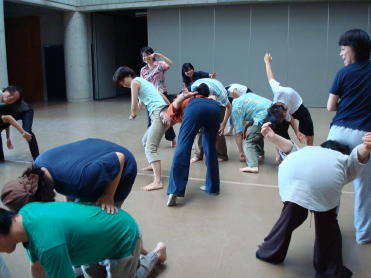

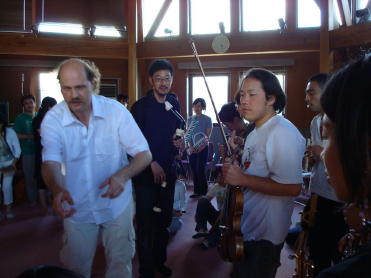
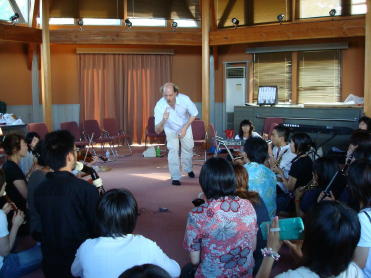
1日目 ミヒャエル ワークショップ
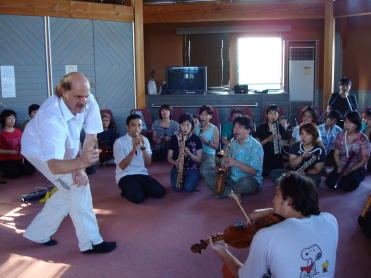
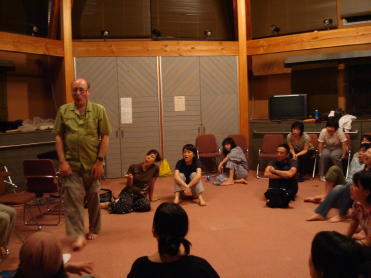
1日目 声の探求
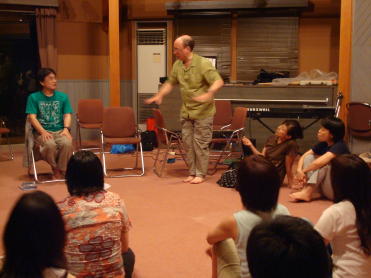
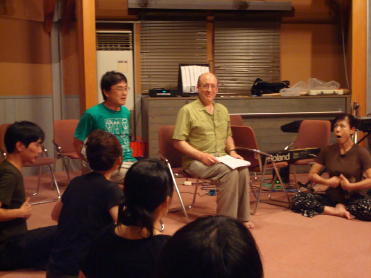

2日目 寺内 ワークショップ
コーネリアス・カーデューのGreat Leaning から Silent Music。
数人のグループで、グループの全員が視界に入る位置に、黙って座っている。
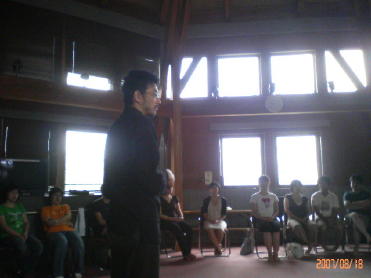
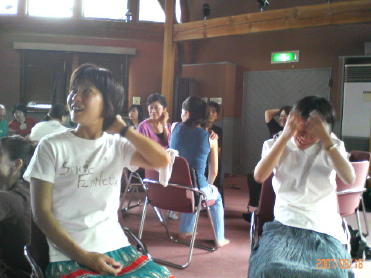
ジャチント・シェルシの曲をヒントにした合唱。 F#の音だけを使って、即興と、2人の指揮者による即興。
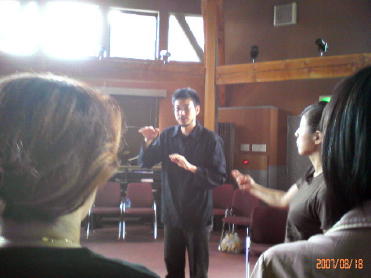
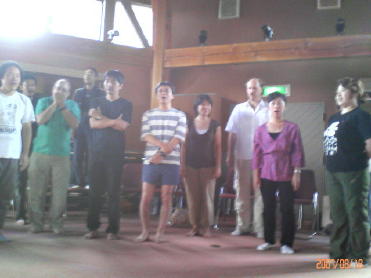
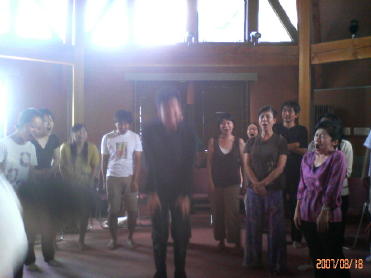
オランダで買ってきたという犬を遊ばせる玩具と、猫を遊ばせる玩具。それぞれランダムな動作をするので、各人がルールを決めて、玩具の動きを指揮者にして即興。
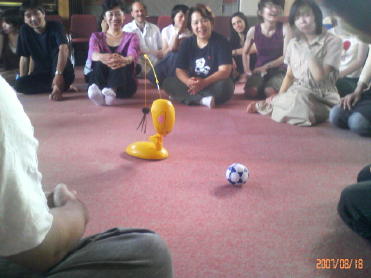
寺内大輔「内と外」初演
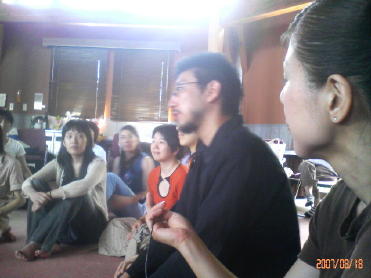
2日目 若尾裕「CMF、この10年の歩み」弾き語り講演。

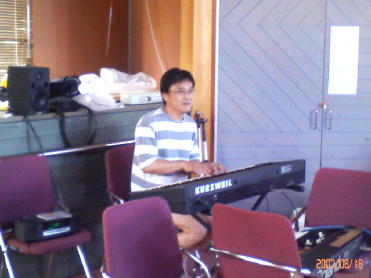
2日目 沼田里衣「音遊びの会」の活動についての講演 「音遊びの会プロジェクト・その後」
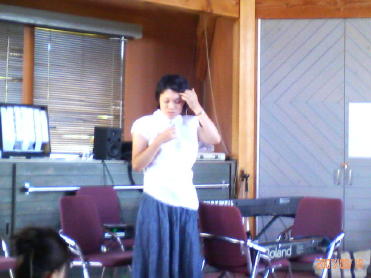
2日目 ミヒャエル・フィッシャー 「ヨーロッパ・フリーインプロヴィゼーションの歴史」

以下は、個人的なメモから (倉本)
[1]アフロアメリカンのフリージャズ・ムーブメント
[2]シュトックハウゼン等の現代音楽からの影響
[3]ルネッサンス、バロック時代の音楽の即興演奏の要素
[4]イギリスのノン・イデオマティック・ミュージック
[5]アフリカン・フリージャズ
[6]インド音楽や東洋の音楽への興味
[7]アメリカの伝統との関係
地域性
ヨーロッパ
ウパガール
ペーター・コワルド、ペーター・ブロッツマン
西ドイツ
コンラッド・バウワー、ギュンター・ゾマー
ロシア
アルハンゲリスク
ハンガリー
ジェルジュ・スラパードシュ
USA
南アフリカ
ブルーノーツ、クリス・マクレガー
流した音源
ネイル[セシル・テイラー、エヴァン・パーカー、ウィリアム・パーカー、トニー・オクスレイ]
カンピエロ・バンド[ローリー・アレン、マイケル・ナイマン]
3本のバネをアンプリファイした作品[ヒュー・デイビス]
スポンテニアス・ミュージック・アンサンブル[ジョン・スティーブンス、デレク・ベイリー、ケント・カーター、トレバー・ワッツほか]
AMM1966
ペーター・コワルド・クインテット
ブローンインザウィンド[モンゲジ・フェザ、クリス・マクレガー、フランク・ペリー]
メサ[イレーネ・シュバイツアー、ルディ・カール、ルイス・モホロ]
かなり時間が足りず、80年代、90年代の動向等は割愛(残念…)
最近、南アフリカ出身のミュージシャン(ルイス・モホロとか、イギリスの Ogun あたりからレコードが出ていて、ソフト・マシーン関係とかとの交流を耳にする機会が多いですが)が取り上げられる事が多い気がして、この日も関連音源を2つも使っていたのが目新しかったり。
2日目 夜のセッションのために、お互いの傾向を知る為の即興セッション。誕生月毎での組み合わせ
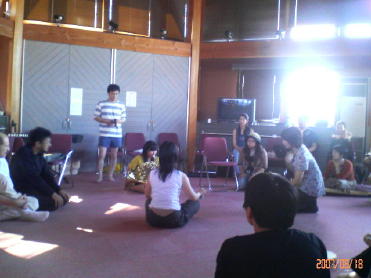
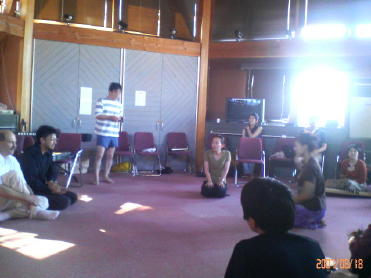
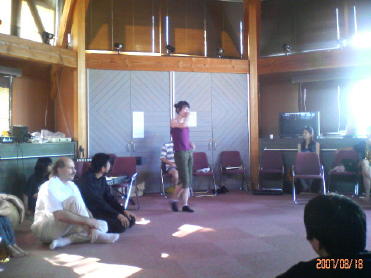
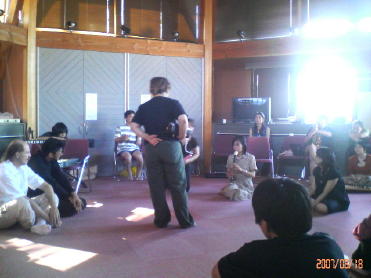
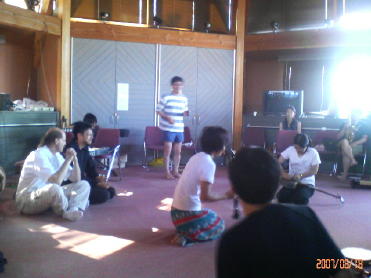
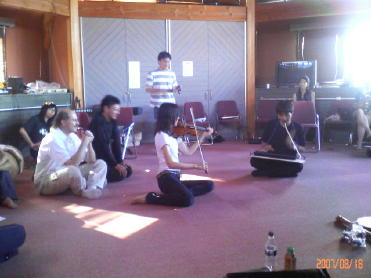
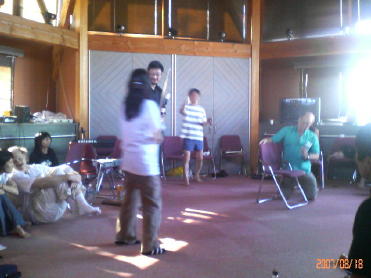
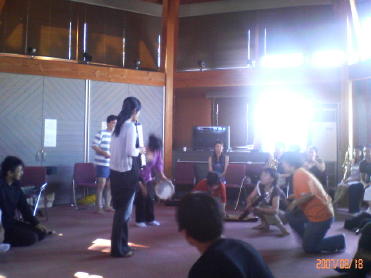
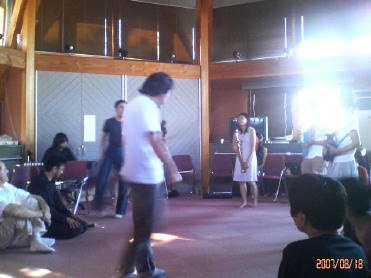

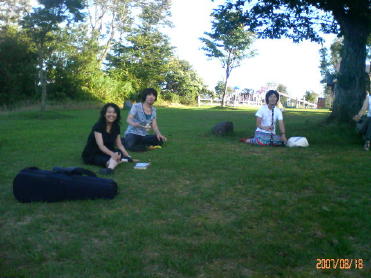
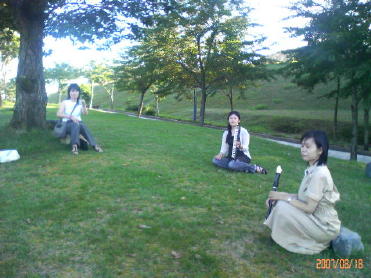

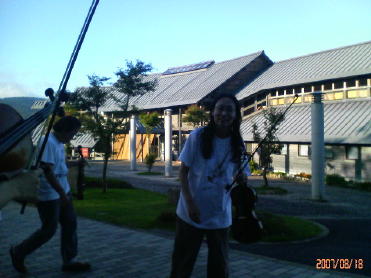
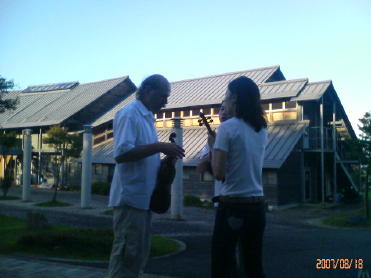

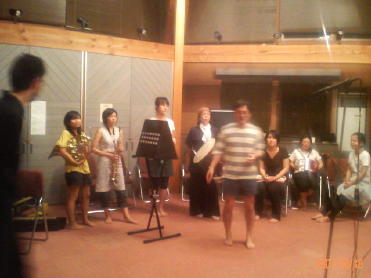
夜のセッション
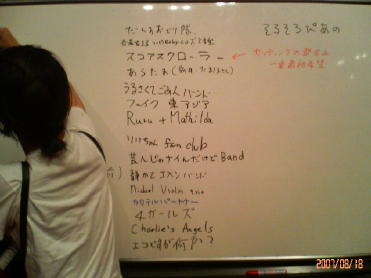
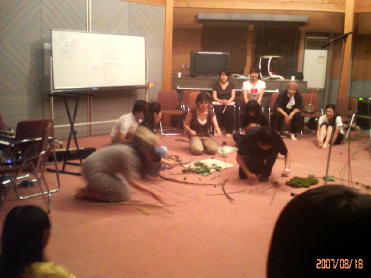

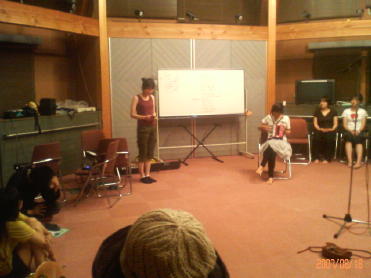
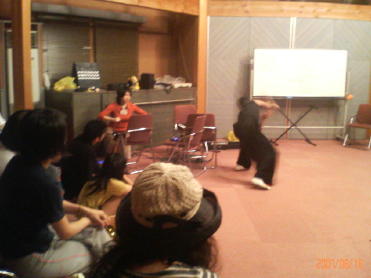
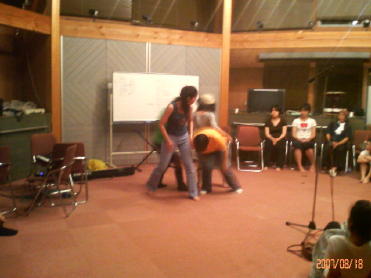
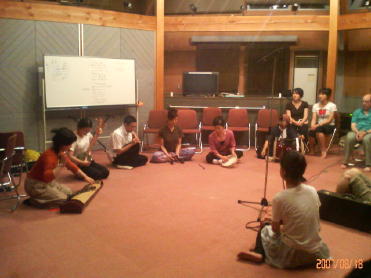
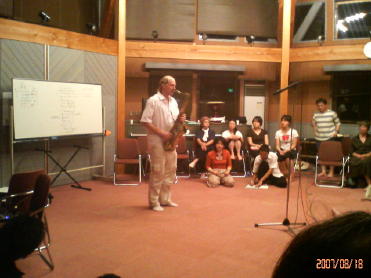
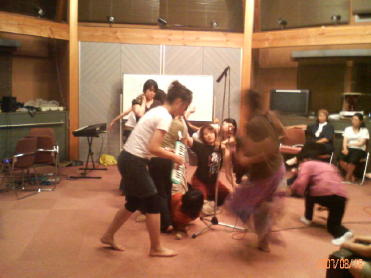
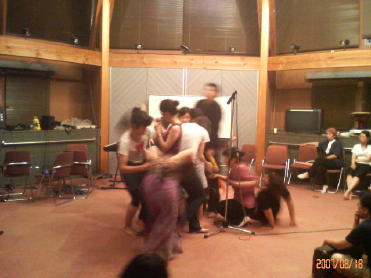
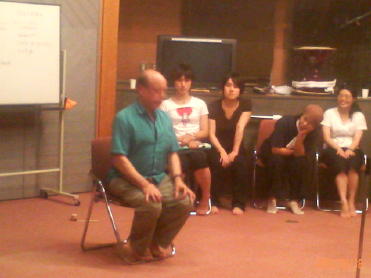

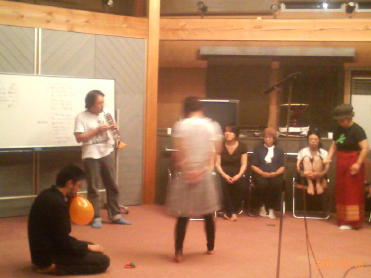
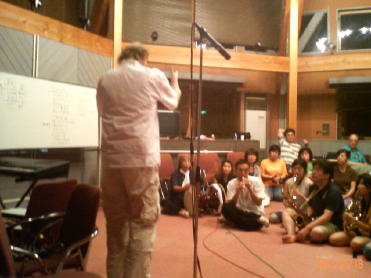
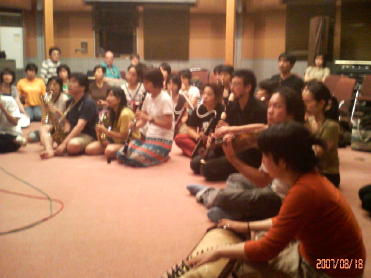
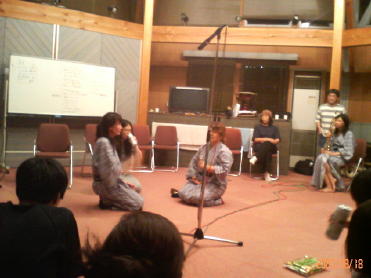
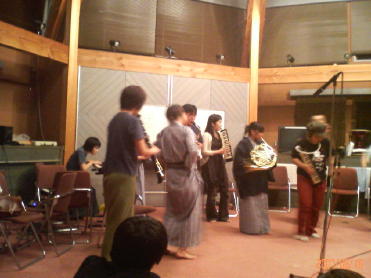


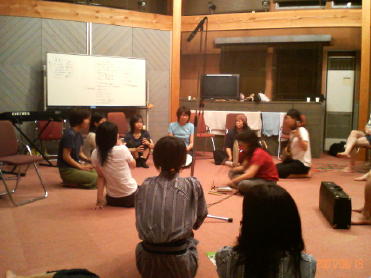
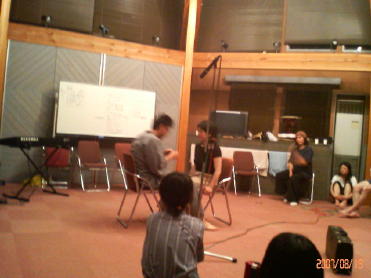
トレヴァー・ウィシャート「声の探求」ワークショップ
3つのグループに分かれて、 Creative Music Festival の歌?を練習して、最後に合わせる


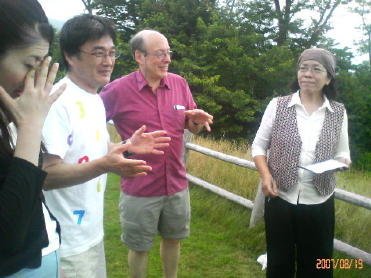
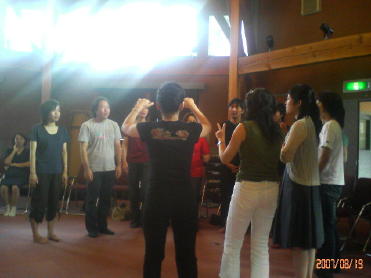
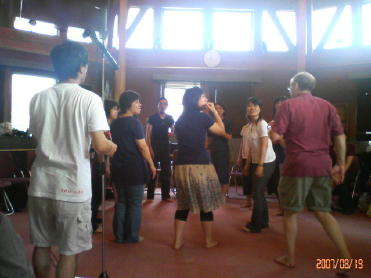

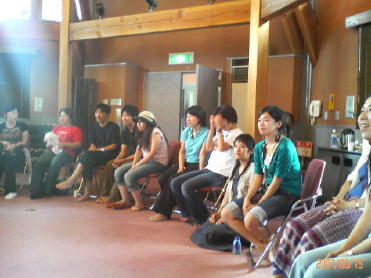
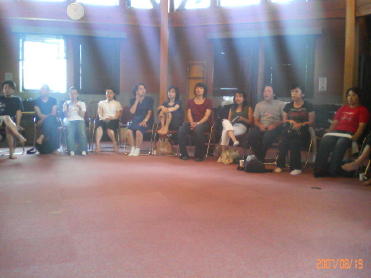
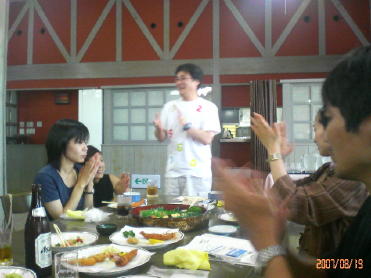
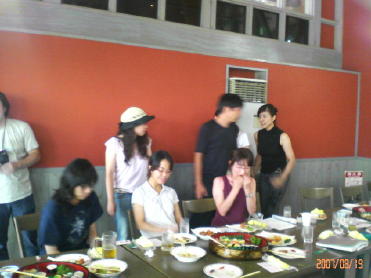
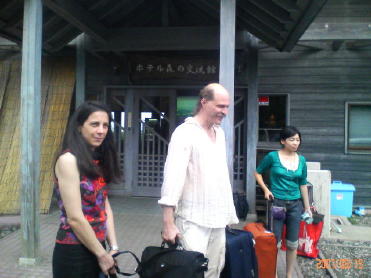

Some thoughts on a history of improvised music in Europe
Michael Fischer
With this lecture I would like to talk about the developments in improvisation mainly with acoustic instruments since the beginning of the 1960ies. Some motives and conclusions of the musicians who were involved will be illustrated by some facts and musical examples.
The beginning of an european improvised music development was very much influenced by the afro-american free-jazz movement in the USA around 1960. The beginning was carried by individuals mainly from a non-academic musical, sometimes non-musical background. Musicians who found a way to express themselves through music based on improvisation, did this of course in many different ways. Influential for the style of improvisation was and is the individual musical environment which builds the personal interest in music or models in music over the years.
Peter Niklas Wilson and Bert Noglik, were two important german writers on the history of improvised music. Bert Noglik wrote in his book ‘Klangspuren’ about several impulses for the developement of an european identified improvised music.
Impulses such as – seven examples:
1) in the early 1960ies improvisation in american jazztradition began to stuck and free jazz florished. The new soundspectrum of players like John Coltrane, Cecil Taylor, Ornette Coleman,or Albert Ayler of course also influenced european musicians.
2) Some musicians combined the sound language of the US american free jazz players with european compositional methods. They were inspired by materials and compositions of composers such as Stockhausen, Cage, Berio, Xenakis, Messiaen, Lutoslawski, Pendercki, Kagel, Ligeti or Webern because of the similarities of the used material. It is interesting that Pierre Boulez said about Anton von Webern’s work: “He gave back the meaning to the sound”. To connect the sound language of US american free jazz with the mentioned composers was a major step in the development of an european identified improvised music.
3) some musicians broke with the american free jazz improvisation style, because they got aware of an european heritage in improvisation f.i. improvisation in Baroque and Renaissance music.
4) musicians in Great Britain started to work on non-ideomatic music based on free improvisation
We are still talking about the impulses for the developement of an european identified improvised music
5) european musicians critizised the american jazz educational tool imitation, they set more value on authenticity
6) the interest of european musicians in different musical traditions based on improvisation increased
f.i. the interest in indian or oriental music styles
7) last but not least there was a discussion amongst european free improvising musicians, how much they see themselves related to the jazz tradition in the USA
All these issues inlfuenced the developement of an european identified improvised music.
In the mid 1960ies small ensembles like the british ‘AMM’ or ‘Joseph Holbrook’ worked on the combination of improvised and composed music. At these times the term ‘instant composition’ was created to describe the situation when a compositional idea is immediately realised within an improvisatoinal context.
End of the 1960ies larger ensembles for improvised music working on the combination of improvised and composed music gained more popularity (such as): Alexander von Schlippenbach’s Globe Unity Orchestra, Misha Mengelberg’s Instant Composers Pool Orchestra, Tony Oxley’s Drum Workshop Orchestra, Barry Guy’s London Jazz Composers Orchestra or the London Improvisers Orchestra.
The sounds of electronic instruments developed in the 50ies and 60ies (f.i. Buchla or Moog) were an additional inspiration for the musicians to work on new structures of sound.
Now I would like to mention some notes on european geographical developments – five examples:
1) Wuppertal, – a small town in the coal-mining region of Western-Germany got famous as one of the cradles of europe’s development in improvised music. Peter Kowald and Peter Brötzmann started their collaboration in 1960/61, performing there every Monday at the same club – two to five listeners were the audience in the beginning.
2) In Eastern-Germany musicians like Conrad Bauer, Ernst Ludwig Petrowsky or Günter Sommer started to play free jazz mid of the 1960ies. In the 1970ies they developed a vivid community of improvising musicians within the country and collaborations with musicians from Poland and Hungary started, followed by invitations from musicians all over Europe. The invitations from western countries made it possibility for the musicians, to leave Eastern Germany and to travel, which was very difficult at these times.
3) In Russia the Ensemble ‘Archangelsk’ made their living by playing dance music for the guests of hotels. Archangelsk is the name of a city at the White Sea, close to Scandinavia. At the end of such parties they sometimes played free improvised music. Beeing more or less isolated from the other musicians in Europe or the USA, they developed over twenty years a very personal style in eclectic improvisation.
4) Hungary composer and pianist György Szabadosz was one of the key figures in terms of combining composed and improvised music with local/’ethnic’ music. In the 1950ies he started to listen to jazz music via radio broadcasts from the USA and started beginning of the 1960’ies to play his own style of free improvised music mostly independently from the improvised music movement in the USA and Europe.
5) South African ensembles like the ‘Blue Notes’ with Christ McGregor, Louis Moholo, Johnny Diyani, Mongezi Feza and Dudu Pukwana or bassist Harry Miller were invited to play in Europe beginning/mid of the 1960ies. The ‘Blue Notes’ were a modern jazz ensemble with african and white musicians. This was not legal in South Africa at these times. Though they were appreciated by the audience in South Africa, they decided to migrate from Apartheid Sout-Africa to England / London where some of them became requested partners of european and american musicians in improvisational contexts.
Now again in general:
From the mid 1960ies on one can see two streams of development in free improvisation in Europe:
On the one hand were the group of musicans following the U.S. free-jazz movement. To name a few:
in Germany Peter Kowald, Peter Brötzmann, Sven-Ake-Johannson, Günter Sommer, in The Netherlands Han Bennink, Misha Mengelberg, Willem Breuker, in Belgium Fred van. Hove, in Switzerland Irene Schweizer.
The other group were musicians following a non ideomatic path from the brithish islands like Derek Bailey, Tony Oxley, Keith Rowe, Evan Parker, Gavin Bryars, John Stevens.
These two streams could also be described as
– a european continental stream following the traditional sound of the instruments, the traditional melodical musical syntax of jazz and free jazz
and
– the stream of musicians from the british islands working more on new playing techniques of the
instruments, non-ideomatic music.
And now lets come to some remarks on the 1970ies, 80ies and 90ies:
In the 1970ies improvised music got wider recognition by being more and more involved in regular jazz festivals with musicians from Germany, Switzerland, Italy, Poland, France and Great Britain. This attracted listeners of jazz music. So also festivals for exclusively free improvised music found more interest and audience.
The new listeners produced a new need for communication. New magazines, radio-shows and institutional ressources were generated and so an additional small market could be established, which garanteed a small financial income for few people involved.
End of the 1970ies and in the 1980ies some of the musicians from the 1960ies established their names as trade-marks in terms of content and recognition, mostly still not in terms of earning money. Especially Wuppertal and musicians from the Brithish Islands could establish themselves as key figures. Connected to this fact is the question how the efforts and benefits are shared among musicians, organizers, journalists and the music industrial infrastructure since then.
The organizers in the 1980ies saw an increasing interest in musicians from formerly communist Europe (f.i. the Ganelin Trio from Russia, Zbignev Seifert from Poland, György Szabadosz from Hungary). Also the combination of local/ethnic music and free improvisation gained more interest.
The 1990ies brought the Personal Computer/LapTop as a new instrument, showing new possibilities and techniques in sound production. Since a few years the performances of only LapTop players, formerly highly appreciated at festivals for improvised music decreased, partly because of a lack of performance. In the meantime performers use the LapTop more as a supporting tool, as an extension for acoustic or electro-acoustic sound generators.
From my point of view at present there is a tendency of standardizing the improvisational musical material.
Improvised music still is not very popular in Europe, though some european states support improvised music – f.e. the music industry and government in Norway and Sweden put a certain amount of money in the development of a creative music infrastructure in the last 15 years. This model succeeded in establishing a more or less new brand of creative music. The improvising musicians in Great Britain were active not only in musical terms, they also worked and established Europe’s best infrastructures for improvised music. Unfortunately many musicians in improvised music stay unknown – but those unknown musicians are building a communication and interaction infrastructure like f.i. in Great Britain. Some musicians are working within local and international web based networks to stay more independent from the established infrastructure of the flow of information in the music bussines.
Let me come to an end with some thoughts on the significance of improvised music:
Free improvised music would not have been attractive till present times if it could not prove as a lasting versatile tool for a common exploration of different musical visions. Derek Bailey, one of Europe’s most influential improvisers once said: “You can approach the unknown with method and compass but not with a map”. Improvised music is still developed as a method and a compass that enables musicians to exchange ideas within different social-, cultural and musical-educational backgrounds. Further it was and is a diplomatic tool for international understanding.
For me the most interesting musicians were always those who communicated an existential need to play this kind of music; musicians who shared their experiences and motivations as a part of their social environment.
One of the beautiful things about improvised music is that it can be played by everybody and it can be a very helpful tool to create interest in the unknown and a responsable and emanzipative society. And this could be the basis for a prosperous community of beeing on this planet.
Thank you for your attention.
ヨーロッパ即興演奏の歴史についてのいくつかの考察
ミヒャエル・フィッシャー
このレクチャーでは, 特に1960年代初頭からの, アコースティックな即興演奏の歴史について, 実例をお聴かせしながらお話ししたいと思います。
ヨーロッパにおける黎明期の即興演奏は, 1960年頃の, アフロ・アメリカン[1]の「フリージャズ・ムーヴメント[2]」から大きな影響を受けて発展しました。はじめは, アカデミックでない音楽[3]や, 特定のバックグラウンド[4]のない音楽から, 個々にもたらされました。自分自身を即興演奏で表現しようとする即興演奏家達は, 言うまでもなく, 様々な方法を用います。即興演奏の様式は, 個々の音楽家の環境や個人的な音楽的興味, その時代のモデルなどから影響を受けています。
Peter Niklas Wilsonと Bert Noglikは, 即興演奏の歴史研究について, 重要なドイツの学者です。Bert Noglikは, ‘Klangspuren’ という本を書きました。その本の中には, 「ヨーロッパ的な即興演奏の発展」の原動力となるいくつかの事柄が述べられています。
次に7つの例を挙げてみましょう。
1.1960年代初頭, アメリカのジャズの伝統が行き詰まり始め, フリージャズが 花開いた。John Coltrane, Cecil Taylor, Ornette Coleman, Albert Aylerといった新しい音楽を実践する即興演奏家達は, ヨーロッパの音楽家に影響を与えた。
2.アメリカのフリージャズの音楽語法とヨーロッパの作曲技法とを組み合わせようとした音楽家もいる。彼らは, 作曲家Stockhausen, Cage, Berio, Xenakis, Messiaen, Lutoslawski, Pendercki, Kagel, Ligeti, Webern の作品に用いられている音楽的素材に類似性を見出したことから[5], ヒントを得た。Pierre Boulezが, Anton von Webernの作品について「彼は音の持つ意味を取り戻した」と語ったことは興味深い。この, 「アメリカのフリージャズの音楽語法とヨーロッパの作曲技法との組み合わせ」は, ヨーロッパ的な即興演奏の発展の主要な段階である。
3.アメリカのフリージャズの様式を壊そうとした音楽家もいる。彼らは, バロックやルネサンスの様式に, ヨーロッパの即興演奏の伝統を見出していた[6]。
4.イギリスの音楽家は, 自由即興演奏の土台として, 「ノン・イディオマティック・ミュージック[7]」を始めた。私達は, 今もこれを「ヨーロッパ的な即興演奏」のアイデンティティだと見做している。
5.ヨーロッパの音楽家は, アメリカのジャズ教育法[8]の真似をすることを批判し, より信頼できる価値[9]を求めた。
6.インド音楽や東洋的な音楽様式など, 他の伝統における即興演奏への興味。
7.ヨーロッパの音楽家達はよく, 「自分達がどれだけアメリカのジャズの伝統と関係しているか」について議論していた[10]。
ヨーロッパ的な即興演奏の発展の影響についてのポイント
1960年代中期には, イギリスの’AMM’ や ‘Joseph Holbrook’ といった小アンサンブルが, 作曲と即興と融合を掲げて活動していました。その頃, 「インスタント・コンポジション」と呼ばれる, 作曲のアイデアを即興演奏の文脈ですぐに実現するといった活動が盛んになりました。
1960年代後半には, より大きなアンサンブルが台頭してきました。Alexander von Schlippenbach’s Globe Unity Orchestra, Misha Mengelberg’s Instant Composers Pool Orchestra, Tony Oxley’s Drum Workshop Orchestra, Barry Guy’s London Jazz Composers Orchestra or the London Improvisers Orchestraなどがそうで, やはり「作曲と即興との組み合わせ」についての興味を持っていました。
また, Buchla や Moog[11]などの電子楽器の発展も, この時期に新たな音楽を作るヒントとなりました。
さて, ここでヨーロッパ各地の状況について, 5つの例を見てみましょう。
1.Wuppertal(ウパタール), ここは西ドイツの石炭の採掘で有名な小さな町だが, ここは, ヨーロッパ即興演奏の黎明期の, 重要な発祥地として有名になった。Peter Kowald とPeter Brötzmannが, 1960年から61年にかけて, 同じクラブで毎週月曜日に一緒に即興演奏を始めた。最初は, 2人から5人程度しかお客さんはいなかった。
2.東ドイツでは, Conrad Bauer, Ernst Ludwig Petrowsky, Günter Sommer といった音楽家が, 1960年代中期にフリージャズの演奏を始めた。1970年代には, 活動はより活発になり, 国内の音楽家のみならず, ポーランドやハンガリーの音楽家との共演なども始まり, また, ヨーロッパ全土からも音楽家たちを招待するといった活動も始まった。当時は, 東側諸国の音楽家が西側諸国へ行くことは極めて困難であったが, 逆は可能性であった。
3.ロシアでは, アンサンブル ‘Archangelsk’ (アルハンゲルスク)が, 生計を立てるためにホテルのゲストのためのダンス音楽を演奏していた。Archangelskは白海の街の名前で, スカンジナビアに近い。彼らは, そうした演奏の最後に, 自由即興演奏をしていた。多かれ少なかれ, 彼らはアメリカからもヨーロッパからも孤立した音楽家達で, 20年以上にもわたって独自の折衷的様式による即興演奏を続けた。
4.ハンガリーの作曲家, ピアニストのGyörgy Szabadoszは, 民俗音楽と作曲, 即興との融合という分野で重要である。1950年代後期, 彼はアメリカからのラジオ放送を聴いてジャズを知り, 1960年代には独学で演奏を始めた。彼の即興演奏は, アメリカ的ともヨーロッパ的とも違う, 彼独自の様式を持っている。
5.1960年代初頭から中期にかけて, 南アフリカでの音楽家Christ McGregor Louis Moholo, Johnny Diyani, Mongezi Feza, Dudu Pukwana,そしてベーシストの Harry Miller 達によるアンサンブル ‘Blue Notes’ がヨーロッパに招待され, 演奏した。 ‘Blue Notes’ は, アフリカ人と白人によるモダンジャズ・アンサンブルであるが, 当時の南アフリカでは, このようなバンドは不法であった。彼らは, 南アフリカの聴衆からの人気を得ていたが, ロンドンに移住することを決めた。彼らのうちの何人かは, ヨーロッパやアメリカの即興演奏家達の要請によって, 共演者になった。
さて, ここでまた, 一般的な事柄に戻ります。
1960年代中期から, ヨーロッパの即興演奏の発展に2つの大きな流れが見られます。
ひとつは, アメリカのフリージャズの流れを汲むグループです。ドイツでは, Peter Kowald, Peter Brötzmann, Sven-Ake-Johannson, Günter Sommer, オランダでは, Han Bennink, Misha Mengelberg, Willem Breuker, ベルギーのFred van. Hove,スイスのIrene Schweizerなどがいます。
もうひとつの流れは, ノン・イディオマティックな音楽性を追及するグループで, イギリスのDerek Bailey, Tony Oxley, Keith Rowe, Evan Parker, Gavin Bryars, John Stevensらがいます。
これらの2つの流れについて, 次のように書かれています。
ヨーロッパ大陸のひとつの流れは, 楽器の伝統的な音に基づいて, ジャズやフリージャズの音楽語法による伝統的なメロディーを奏でる音楽家達, 一方, もうひとつの流れは, 新しい演奏法を追及しノン・イディオマティックな音楽性を追求するイギリスの音楽家達である。
さて, そろそろ1970年代, 80年代, 90年代について述べたいと思います。
1970年代には, 即興演奏はより広く認められるようになり, ドイツやスイス, イタリア, ポーランド, フランス, イギリスなどのジャズフェスティバルとも関わるようになります。
それは, ジャズのリスナーに気に入られました。そして, 自由即興演奏に特化したフェスティバルも聴衆の興味を獲得しました。
新たな聴衆は, 新たなコミュニケーションの必要性を生み出しました。新しい雑誌, ラジオ番組, 公的な補助金などが生まれ, 少数の人々のための僅かな収入を保証するマーケットも設立されました。
1970年代終わりから1980年代にかけて, 即興演奏の認知度が高まるにつれ, 1960年代から活動している音楽家達が, 彼らの名前をトレードマークとして確立するに至りました(その多くは, お金を十分に稼げていませんでしたが)。
特に, Wuppertalと, イギリスのミュージシャンは, 彼ら自身を重要な地位に導いています。
これと関連したひとつの疑問は, 音楽家, 企画者, ジャーナリスト, 音楽業界の間で, どのように収益を分配していたか, ということです。
1980年代の企画者たちは, ヨーロッパの共産主義から数多くの面白い音楽家達が出てきたことを目の当たりにしていました(例えば, ロシアのGanelin Trio, ポーランドのZbignev Seifert, ハンガリーのGyörgy Szabadoszなど)。そして, 民俗音楽との融合もまた, 即興演奏を面白くすると思っていました。
1990年代には, コンピュータの普及により, より個人的な音楽がもたらされました。コンピュータを新しい技術や音作りのツールとして使うのです。近年では, 即興演奏のフェスティバルが減り, ラップトップ・コンピュータのみの演奏が注目されています。時には演奏者不在の演奏まであります。
昔は, 音楽家はラップトップ・コンピュータは, あくまでも補助道具として使っていました。 生音にエフェクトをかけるとか, エレクトロアコースティックの音を出すとかです。
さて, ここでの私の視点は, 音楽的素材の標準化の傾向についてです。
ヨーロッパでは, 即興演奏は, 数多くの国や地方から助成を受けているにも関わらず, まだポピュラーとは言えません。ノルウェーやスウェーデンの政府や音楽産業は, ここ15年創造的な音楽の発展のためにお金を助成してきました。このことは, 創造的な音楽の新しいブランドを確立したという意味では, 成果があったと言えます。
イギリスの即興演奏家達は, 音楽への興味だけ[12]で活動していたわけではなく, 即興演奏のためのヨーロッパで最も良い土壌を作ったと言えます。多くの音楽家は無名のままですが, 彼らは, 音楽家同士のコミュニケーションの場を作ってきました。何人かの音楽家は, 地方から国際的なネットワークまで, インターネットをベースとして, 音楽ビジネスから独立した場を築き上げています。
さて, そろそろまとめに入りましょう。
もし, 自由即興演奏が, 異なる音楽ヴィジョンの普遍的探求のための永続的で柔軟な道具になりえなければ, それは現在まであまり魅力的なものではなかったでしょう。ヨーロッパの最も重要な即興演奏家のひとり, Derek Baileyは, 次のように言っています「君は, 方法とコンパスさえ持っていれば, 地図がなくとも未知の世界に近づける。[13]」。
即興演奏は, 異なる社会, 文化, 音楽教育, 音楽的バックグラウンドを持つ人々がアイデアを交換することによって, 今も発展しています。もっと言えば, 即興演奏は, 国際理解のための外交手段でもあったのです。
私にとって最も興味深い音楽家は, この種の音楽を演奏する個人的必然性(「お金のため」とか, そういうのではなくて)と向き合っている人です。つまり, 社会的に経験と動機を分かち合う音楽家達です。
即興演奏において最も美しいと思うことのひとつは, それが誰でも演奏できて, 何か未知の面白いことを作る援けとなることです。責任はあるが解放された社会, それは, この惑星でみんながうまくやっていくことの基礎になると思います。
ご清聴ありがとうございました。
*各ページの脚注は, 訳者による補足説明です。ミヒャエル・フィッシャーに訊いたものもあります。
[1] アフリカ系アメリカ人
[2] 伝統的なクリシェから解放された新しいジャズ
[3] いわゆる音楽大学などで習う音楽をアカデミックな音楽, と呼ぶ。近年は音楽大学で習う音楽内容も変わりつつあるが, ここではおそらく伝統的なクラシックやジャズを指す
[4] クラシックやジャズなど, 特定のジャンル
[5] 楽器を伝統的でない方法で奏するという点だそうです
[6]これは, アメリカのフリージャズに強くとらわれていた状況を意味している。
[7] どんなジャンルにも属さないように聴こえる音楽
[8] 例えば, 「ジョン・コルトレーンの真似をしてみよう」といった技術的な教育
[9] 個人的な音楽表現
[10] どちらが良い, という問題ではなく, それぞれの態度の人がいた
[11] シンセサイザーのメーカー
[12] ここでの「音楽への興味だけ」は, 「ビジネスには関心がない」という意味
[13] ここでの「方法とコンパス」とは「音楽の方向性」を, 「地図」とは「書かれた結果」を表わしているものと思われる。
まず,全体的な感想ですが,ディスカッションの時にも述べたように,ワークショップやレクチャーのバランスがよく,とても充実したものだったと思います.ただ(これもディスカッションの際に述べたことですが),各ワークショップの終了時に,皆の経験を共有しあい,ファシリテータにお返しする時間がとれなかったのが,残念でした.
以下に,プログラムの進行順に,個々のメニューの感想を述べたいと思います.
ワークショップ1(ミヒャエルの自由即興オーケストラ)
あれだけの人数で,しかも,大きな音の楽器から小さな音の楽器までバラエティに富んだ状況で,正にオーケストラのような,一体感のある演奏ができあがる過程を楽しむことができ,初っ端からとても刺激的でした.ミヒャエルのファリシテートは,それぞれの作業で,何を目指しているのか明確だったので,音を出すこと,聞くことにとても集中しやすかったです.
ワークショップ2(体奏)
新井さんのワークショップは,楽しいと同時に,体がほぐれて,とても気持ちの良いものでした.時間が十分でなかったことが,本当に残念です.このような体をほぐすワークショップは,毎回,プログラムに入れて欲しいと思います.また,このようなワークショップを,プログラムの冒頭や,毎朝一番に行うと,「準備体操」になって,それぞれのプログラムに,より没入できるような気がします.
ワークショップ2(口琴)
色々な口琴が楽しめたという点については,良い経験だったのですが,ミヒャエルのワークショップや,クリエイティブ合唱団に比べると,何を目指しているのかが見えにくい,どっちつかずな感じの時間が過ぎてしまったように思います.このワークショップを通じて,口琴(とそれによる音楽)というのがとてもintimateなものであることを,再確認できました.
ワークショップ3(声の探求)
これまた,何を目指しているのかが,とても明確なワークショップだったので,入り込みやすい,とても良いワークショップだったと思います.自分ではうまく出せない音があり,もどかしさを感じたことまで楽しめてしまう内容でした.
セッション1
お風呂の時間を気にして人がサッと居なくなったところで,自然発生的に出来上がったピアニカ軍団の存在感に圧倒されてしまい,ピアニカ軍団の独壇場となってしまったのが,失敗でした.(演奏としてはわりと面白かったので,一人の聞き手としては,全く文句はないのですが)
ワークショップ4(クリエイティブ合唱団)
このワークショップは,それぞれのネタにおいて,寺内君が何を求めているかが明確だったので,それぞれのネタの世界に簡単に入り込むことができ,素晴らしいものでした.「内と外」という作品の体験に関して,1回目の体験中は,自分の中の音楽をうまく掴み取ることができず,苦行に近い状況でした.しかし,途中で一度ストップがかかった際に,自分の中の音楽を掴み取るためのストラテジーを見直すことができたので,2回目は楽しむことができました.この作品については,一度ある程度長めの練習試行をした上で,本試行をすると,寺内君が提案するこの作品の持つ世界を楽しめる人が,より増えるのかもしれません.
#参加している人が,優れた音楽家ばかりであれば,そのような必要はないかもしれませんが.
レクチャー1(若尾先生弾き語り)
プログラムを始めてみたとき,「レクチャー」と「弾き語り」という語が並んでいることに,「???????」でしたが,傑作なレクチャーだったと思います.もし,誰かがこのレクチャーを録音していたならば,たとえ音質が悪くても,今年のCMFのCDに入れて欲しいと思っています.
情報交換(「音遊びの会プロジェクト・その後」)
とても興味深いネタであるのに対して,調理がいまいちであったように思います.とてももったいない.
レクチャー2(ミヒャエル)
これまた興味深い内容で,良いヒントをもらいました.ゲストの方に,ワークショップだけでなく,レクチャーもやってもらうというのは,ゲストの世界観をより多面的に見ることができる,とても良いプログラム構成だと強く感じています.時間の都合で端折った部分も興味があるので,レクチャー用の原稿がホームページに掲載されるのが,待ち遠しいです.
セッション2
12回の1分限定セッションは,実に,面白かったです.1人30秒の自己紹介を削ってでも,別の組合わせでもう1順しても良かったのかなとも思います.
コンサート
参加者の皆さんの豊かな創造力に刺激され続けた,楽しく豊かな時間でした.CMFオーケストラが,ワークショップの時以上に良い演奏で,本当に気持ち良かった.
コンサートの出し物について,自己申告だけでなく,推薦枠もあると,より良いように思います(時間の制約もあるので,全員が提案をするのは難しいと思いますが,例えば,抽選で3名に推薦枠があたるとか,現実的な方法はあるように思います).
ワークショップ5
このワークショップは,確かにやるのも無茶苦茶楽しかったのですが,やっていると全体像がバランス良い状態で聞けないのが残念でした(もしかしたら,ウィシャートが一番楽しかったのではないかとも思ってしまいます).録音が楽しみです.
ディスカッション
ワークショップを閉める前に,皆で感想を共有する時間が必須であることを,再認識しました.ディスカッションにゲストのお2人が加われなかったのが,唯一,残念でした.
お別れパーティー
給仕の問題で,最初に,乾杯ができなかったことを除けば,文句のない,楽しいパーティーでした.
番外編
車座タイム(初日,2日目の夜)
今年は皆が泊まり込みだったので,時間を気にせず,ゆっくり話すことができました.アイディアの交換あり,人生相談ありの,充実した時間で,これも,CMFの醍醐味の1つだと思っております.来年以降も,是非,続けたいと思います.
<永幡幸司さんの感想>